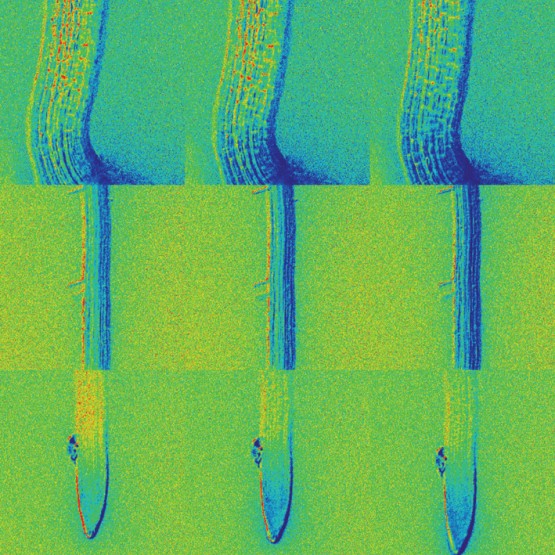Biologists at UC San Diego have succeeded in visualizing the movement within plants of a key hormone responsible for growth and resistance to drought. The achievement will allow researchers to conduct further studies to determine how the hormone helps plants respond to drought and other environmental stresses driven by the continuing increase in the atmosphere’s carbon dioxide, or CO2, concentration.
A paper describing their achievement appears in the April 15 issue of the scientific journal eLife.

Time sequence shows how mustard seedlings take up and distribute ABA through roots and other parts of the plant during germination. Credit: Rainer Waadt, UC San Diego
The plant hormone the biologists directly tracked is abscisic acid, or ABA, which plays a major role in activating drought resistance responses of plants and in regulating plant growth under environmental stress conditions. The ABA stress hormone also controls the closing of stomata, the pores within leaves through which plants lose 95 percent of their water while taking in CO2 for growth.
Scientists already know the general role that ABA plays within plants, but by directly visualizing the hormone they can now better understand the complex interactions involving ABA when a plant is subjected to drought or other stress.
“Understanding the dynamic distribution of ABA in plants in response to environmental stimuli is of particular importance in elucidating the action of this important plant hormone,” says Julian Schroeder, a professor of biology at UC San Diego who headed the research effort. “For example, we can now investigate whether an increase in the leaf CO2 concentration that occurs every night due to respiration in leaves affects the ABA concentration in stomatal cells.”
The researchers developed what they call a “genetically-encoded reporter” in order to directly and instantaneously observe the movements of ABA within the mustard plant Arabidopsis. These reporters, called “ABAleons,” contain two differentially colored fluorescent proteins attached to an ABA-binding sensor protein. Once bound to ABA, the ABAleons change their fluorescence emission, which can be analyzed using a microscope. The researchers showed that ABA concentration changes and waves of ABA movement could be monitored in diverse tissues and individual cells over time and in response to stress.
“Using this reporter, we directly observed long distance ABA movements from the stem of a germinating seedling to the leaves and roots of the growing plant and, for the first time, we were able to determine the rate of ABA movement within the growing plant,” says Schroeder.
“Using this tool, we now can detect ABA in live plants and see how it is distributed,” says Rainer Waadt, a postdoctoral associate in Schroeder’s laboratory and the first author of the paper. “We are also able to directly see that environmental stress causes an increase in the ABA concentration in the stomatal guard cells that surround each stomatal pore. In the future, our sensors can be used to study ABA distribution in response to different stresses, including CO2 elevations, and to identify other molecules and proteins that affect the distribution of this hormone. We can also learn how fast plants respond to stresses and which tissues are important for the response.”
The researchers demonstrated that their new ABA nanosensors also function effectively as isolated proteins. This means that the sensors could be directly employed using state-of-the-art high-throughput screening platforms to screen for chemicals that could activate or enhance a drought resistance response. The scientists say such chemicals could become useful in the future for enhancing a drought resistance response, when crops experience a severe drought, like the one that occurred in the Midwest in the summer of 2012.
The study was supported by grants from the National Science Foundation and, in part, the National Institutes of Health and the U.S Department of Energy’s Division of Chemical Sciences, Geosciences, and Biosciences in the Office of Basic Energy Sciences.
Source: University of California, San Diego
Published on 16th April 2014


